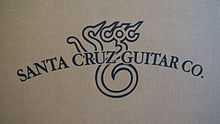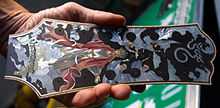Santa Cruz Guitar Company

Santa Cruz Guitar Company is an American manufacturer of acoustic guitars, located in Santa Cruz, California. The company was started in 1976 by luthier Richard Hoover, who is reputed to have "trained some of the most accomplished contemporary luthiers in his workshop", and investors Bruce Ross and William Davis.[1] They produce somewhere between 500 and 700 guitars a year,[2][3] and their instruments are known for being "some of the world’s finest steel-string guitars"[1] with characteristics described as "being highly resonate and having a complexity of overtones".[3]
History
Luthier Richard Hoover began learning his craft from Bruce McGuire and Jim Patterson in the late 1960s, and became well known in his home town of Santa Cruz, California after having run his own guitar repair and manufacturing shop for several years. In the early 70s there was little information on building steel-string guitars available, and builders like Hoover, Bob Taylor, Jean Larrivée, and Michael Gurian started collaborating, sharing ideas, tools, and techniques as they discovered them.[1] Hoover also learned from reading an "armload of books on how to make violins", supplied by his mother who was a reference librarian,[2] and learned techniques on wood finishes from a Swedish finish carpenter.[1]
In 1976 Hoover was approached by investors Bruce Ross and William Davis, who wanted to start their own acoustic guitar company. Hoover had made his own guitar and he was invited to be part of the team. The name "Santa Cruz Guitar Company" was initially only a place-holder name, expected to be replaced when they came up with a better one, which never happened.[1] The company's first model was called the "D", a dreadnought which they wanted to have a tone that had a balance between bass and treble. They chose to use koa wood for the sides and back, a wood that was commonly used in the beginning of the twentieth century, but became rare during the Great Depression.[1]
The company saw many things happen in 1978. William Davis left the company because it was struggling to make a healthy profit. Hoover purchased Davis's share of the company. They introduced the H model, named after the initial of Paul Hostetter's last name, as he was the person who introduced the guitar's concepts to Hoover and Ross. [1] The FTC model was also introduced, which has a flat top with a carved, arched back. This model was a limited edition run, with the 17th of the series being bought by Eric Clapton. The FTC was later altered into the F model which has a flat back, a plainer fretboard, and with the cutaway an option. Lastly, they started collaborating with Tony Rice, building a model based on his Martin d-28,[4] a guitar that has gotten some odd modifications done to it by various repairmen. Rice started touring with the guitar which lead to the company receiving many phone calls. They realized they had a something offered by nobody else, and the Tony Rice model was introduced as a standard in 1981.[1]
Richard Hoover bought out Bruce Ross in 1989 (who went on to pursue his current career in Family Therapy) and made several changes, for instance standardizing headstock shapes and neck widths on some models to get the amount of variation down. By the 1990s they had over 20 standard models, including 12 fret, smaller bodied guitars, and offered a variety of different customization options, including tone woods (Cocobolo, Ziricote, Brazilian, Figured Mahogany, etc), custom neck shapes, inlays and custom voicing/bracing.

During their entire history the company has paid high attention to detail, and kept their size limited to be able to make each instrument sound its best.[1] They have worked diligently on developing new designs and understanding of materials to allow for a greater variation in tone, because where traditional guitars were required to produce a certain amount of volume in order to compete with other instruments, smaller bodied guitars can now be amplified with a microphone if necessary.[3] The company uses both reclaimed wood and responsibly harvested new wood, having had a "green philosophy […] from the company's beginning".[3][5] Due to the company's reputation they are often approached by others who have wood available, as for instance when they in 2009 built guitars after accepting an offer for Brazilian rosewood harvested in the 1930s.[6]
Their guitars are often perceived as being expensive, which might be due to some of their more well-known models having expensive options, e.g. one review lists the Don Edwards signature model "Cowboy Singer" at £4,300 (approx. US$6,850 as of March 2012).[7] Other models are priced similar to equivalently featured instruments from other makers.[1]
Notable players
- Tony Rice[1]
- Bob Brozman[1]
- Disappear Fear[1]
- Don Edwards[3][7]
- Brad Paisley[2]
- Robert Plant[2]
- Ben Harper[2]
- Elvis Costello[3]
- Lloyd Cole[3]
References
- ↑ 1.0 1.1 1.2 1.3 1.4 1.5 1.6 1.7 1.8 1.9 1.10 1.11 1.12 Grisman, David (2005). "Richard Hoover of Santa Cruz Guitars". Fretboard Journal (1). Retrieved March 6, 2012.
- ↑ 2.0 2.1 2.2 2.3 2.4 Brad Kava (November 14, 2011). "Handmade Guitars Aren't Endangered, says Longtime Santa Cruz Guitar Maker". SantaCruzPatch. Retrieved March 6, 2012.
- ↑ 3.0 3.1 3.2 3.3 3.4 3.5 3.6 Kelly, Jake (Sep 1, 2011). "Inside The Trojan Horse: Santa Cruz Guitar Company". American Songwriter. Retrieved March 11, 2012.
- ↑ Sandra Beasley (February 14, 2014). "Tony Rice, Guitar Hero". The New York Times. Retrieved February 17, 2014.
- ↑ "Richard Hoover of Santa Cruz Guitars Shares His Passion". Dec 11, 2011. Retrieved March 11, 2012.
- ↑ Burgess, Chris; Drake, Gayla; Smith, Path (July 2009). "Hands On With Santa Cruz Guitar Company's 1934 D". Premier Guitar. Retrieved March 11, 2011.
- ↑ 7.0 7.1 Saufley, Charles (May 2011). "Santa Cruz Don Edwards Cowboy Singer Guitar Review". Premier Guitar. Retrieved March 11, 2011.